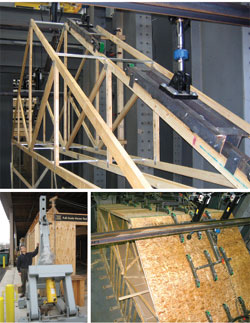Applied Science
About a year before the SBCRI came online, the APA added 5,000 square feet to its 37,000-square-foot research facility in Tacoma, primarily to build and conduct testing on a 25x37x 9-foot, full-scale house.
Industry and market pressures drove APA to upgrade its testing capabilities. While wood framing systems continue to dominate residential building nationwide, competing materials and multiple code provisions for wall bracing raise questions about their equivalency in actual performance.
“The codes want to quantify all of the different [wall bracing] systems to make sure [the code term] ‘or equivalent’ is an accurate provision,” says Yeh. “But how much stronger or better it is within a system is very difficult to quantify unless you test in three dimensions.”
The 23 tests APA conducted at the facility have gone a long way to measure the effectiveness of structural wood sheathing and hold-downs, among others, in the context of a full-scale system.
For instance, by pushing on one wall line at one or several points in varying degrees and seeing how the others react, and putting a number to those tests, Yeh and his research team can report that a house with fully sheathed walls is about 80% to 90% stronger than one with OSB panels applied only at the corners of the building.
Other tests confirm that panel sections placed above and below window and door openings add a higher level of rigidity to the overall structure, prove that hold-downs in the corners add 10% more load capacity at those points, and further legitimize the structural value of the narrow wall bracing design that APA promotes. “Our results address some skepticism and allow that system to better compete,” Yeh says.
The testing, Yeh says, also challenges manufacturers and trade groups of competing systems to follow APA’s lead and quantify their structural claims. He also anticipates that such results, and those to come, will lead building codes to classify more clearly the relative value of various structural systems and lead to changes in housing design and the amount of materials needed to build, instead of assuming all systems are equal in the code or other standards.
“If one material is 10 times stronger than another, you may not need as much of it on the wall to achieve the same performance,” says Yeh, quoting OVE scripture. If so, he says, a builder may also be able to place bigger windows within a stronger structure to help make a house more marketable.
Like Grundahl, Yeh looks to evolve the APA’s testing, specifically regarding issues of load distribution and flow through the building, the value of interior drywall on the home’s rigidity, and discovering a full-scale system’s ultimate structural capacity–by pushing it to the point of fracture. “Then we’ll truly know what it is capable of handling,” he says.



